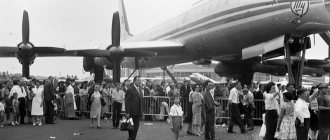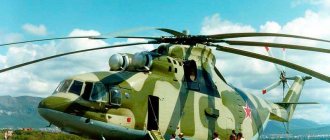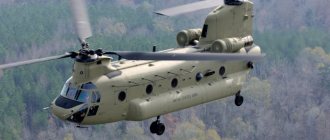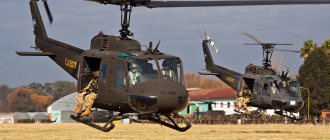Enriched with experience in the design and regular operation of the first wide-body passenger aircraft Il-86, the team of the Design Bureau named after. S.V. Ilyushin under the leadership of G.V. Novozhilov created a new aircraft - Il-96-300. The aircraft has the design of a cantilever monoplane with a low wing and a classic tail. Designed to transport three hundred passengers, luggage and cargo with a total weight of up to forty tons on intra-highway lines of 4000-9000 km. It is also envisaged to use it on lines with a length of up to 11,000 km with a change in the number of seats in the cabins.
Il-96-300 - video
The fuselage of the new aircraft has the same diameter as the fuselage of the Il-86 (6.08 m), but is shorter—by five meters—in length. Special studies and experiments carried out by the Design Bureau team together with TsAGI specialists helped to design a high aspect ratio swept wing with supercritical profiles and vertical tips that increase its aerodynamic qualities. The tail unit is the same as on the Il-86; to improve directional stability in case of failure of one engine in flight, the area of the vertical tail unit has been increased.
The landing gear of an aircraft consists of three main legs located behind the center of mass and a nose gear. Each of the three main legs is equipped with a four-wheel trolley with brake wheels, and the front leg has two non-braking wheels. All fourteen wheels have the same dimensions 1300x480 mm and pressure.
The power plant consists of four PS-90A turbofan engines designed by P.A. Solovyova. The fuel system operates automatically, but manual control is possible if necessary. The fuel is located in nine tanks, of which eight are located in the wing consoles and one in the center section. The system is designed separately for each of the four engines. The consumable compartments are constantly filled with fuel, which ensures its reliable supply to the engines in all flight modes.
The Il-96-300 aircraft is a double-deck aircraft; like the Il-86, it is designed for operation in two versions - tourist and mixed. The main one is the tourist one, in its salons the seats are installed in three rows of nine seats each with two aisles, the front salon accommodates 66 passengers, and the rear one - 234. The mixed layout for 235 passenger seats differs from the first option in the presence of two front salons: the first salon class for 22 highly comfortable passenger seats, and a business class cabin for 40 passenger seats. To serve passengers in these salons, additional buffet and kitchen equipment is installed.
During a long flight, passengers will be provided with two meals a day; for this purpose, there is a buffet and kitchen complex on the lower deck. On the lower deck there are three large compartments, two for cargo in standard containers, the third - mainly for “piece” non-containerized cargo. The front and rear compartments accommodate 16 containers; if all the passenger seats on the upper deck are occupied, then nine containers carry their luggage, and seven carry mail and urgent cargo.
The Il-96-300 aircraft first took off on September 28, 1988 with a crew led by test pilot S.G. Bliznyuk. Test flights showed that the vehicle is reliable and easy to operate. On June 14, 1993, regular passenger transportation began on the new car. The plane is the flagship of the Russian civil fleet; it is not for nothing that the President of Russia flies on it.
Modifications
Il-96-300
Basic version with PS-90A engines (4 × 16,000 kgf). The aircraft made its first flight on September 28, 1988, and received an airworthiness certificate on December 29, 1992. The first Il-96-300 entered service with Aeroflot in 1993. Currently, in addition to Aeroflot, only State Customs Committee Russia is used as VIP transport and Cuban Cubana, including as transport for the President of Cuba. Mass-produced at the VASO plant in Voronezh. The only passenger aircraft of the series in service. 20 aircraft were produced, including prototypes. On August 11, 2009, it was announced that the Il-96-300 aircraft would be withdrawn from production as “unpromising.” As of November 2015, production has not been curtailed. Maximum take-off weight is 250 tons, payload is 40 tons. The flight range at maximum load is 9,000 km, with the number of passengers 269 people and with a full supply of fuel - 13,500 km. Passenger capacity in a three-class cabin is 235 people, in a two-class layout - 262, in economy class - 300 people.
Il-96-300PU/PU(M1)
A special version of the Il-96-300, designed to transport the Russian President. Il-96-300PU (“control point”) was built in four copies. There are practically no differences in flight performance from the basic version, except for the increased range due to some modifications. The aircraft is equipped with equipment that allows it to control the armed forces in the event of a nuclear conflict. Externally, the aircraft also does not differ from the basic version, with the exception of the characteristic chute in the upper part of the fuselage. The first aircraft of this version was assembled in 1995 for Boris Yeltsin. The second, for Vladimir Putin, Il-96 took off on April 21, 2003. The third one took off for the first time in August 2012. The fourth - in August 2013. The fifth - in November 2015.
Il-96-400
Received as a modification of the Il-96M - the fuselage was inherited (longer than the Il-96-300), PW engines were replaced with PS-90A-1 (more thrust than PW engines). The Il-96-400 aircraft is a deep modernization of the Il-96-300 with PS-90A-1[36] engines with a thrust of 17,400 kgf and improved avionics. The fuselage was “borrowed” from the Il-96M. As of 2013, an order appeared for the supply of three aircraft to Cuba. Maximum take-off weight is 270 tons, payload is 58 tons. Maximum passenger capacity is 435 people. The maximum flight range is 13,000 km.
Il-96-400T
It is a cargo version of the Il-96-400. Flight performance indicators remained unchanged. Produced at the VASO plant in Voronezh. The first Il-96-400T was created by reconstructing the Il-96T, assembled in 1997. In 2007, an entirely new aircraft was assembled. Both aircraft were sold to Atlant-Soyuz in 2007, and in 2009 they were transferred to Polyot. As of May 2011, three aircraft were successfully operated in the Poljot fleet; their operation with the airline was completed by July 2013. The fourth aircraft for Polyot (RA-96104) was built and flown, but was not transferred to the airline due to financial problems of Polyot. As of 2014, it is being rebuilt into an Air Control Center by order of the FSB of the Russian Federation with the designation Il-96-400VPU with the installation of windows, additional exits, including an exit in the lower part of the fuselage, characteristic of the Il-96-300VKP and Il-86, allowing loading passengers without resorting to the supply of ladders. At the beginning of 2015, the Ministry of Defense announced the purchase of a trial batch of 2 Il-96-400T aircraft in the “strategic tanker” modification. Further, in case of successful operation, the possibility of purchasing about 30 aircraft of this modification is being considered.
Il-96-400TZ
As reported on January 6, 2015 by the Press Service and Information Directorate of the Ministry of Defense of the Russian Federation, the Ministry of Defense entered into a contract with United Aircraft Corporation OJSC for the construction of 2 Il-96-400TZ tanker aircraft. The new Il-96-400TZ tanker aircraft will be capable of transferring over 65 tons (40 tons on the Il-78M) of fuel at a distance of up to 3.5 thousand km. (on the Il-78M 3 thousand km.). The aircraft will be equipped with universal UPAZ-1 aviation refueling devices, which have proven themselves on existing operational Il-78/78M tanker aircraft.
Il-96VKP
This modification will replace the IL-86VKP. Currently (December 2015), the United Instrument-Making Corporation is working to create a promising third-generation airborne strategic control center complex.
Il-96M
Modified Il-96-300 - fuselage lengthened, PW engines, Collins instrumentation. This is the first Russian aircraft developed in collaboration with Western companies. Only one prototype was made. In March 1993, the fuselage of the experimental Il-96-300 was lengthened, the PS-90 engines were replaced with Pratt&Whitney PW2337 (for the first time in the history of Russian aviation, American engines were installed on an aircraft) with a thrust of 17,030 kgf, and Western avionics were installed. The aircraft made its first flight on April 6, 1993. In 1997, the Il-96M was certified in the USA. It was repeatedly demonstrated at various air shows, at MAKS-2003 it was demonstrated under the designation Il-96-400 with NK-86 engines. In May 2009 it was cut up. According to all the main indicators, the Il-96M became a “record holder” among Soviet passenger aircraft: it is capable of carrying up to 435 passengers, the maximum payload is 58 tons, the maximum take-off weight is 270 tons, the practical flight range is 12,800 km.
Il-96MD
The aircraft is powered by two Pratt & Whitney PW4082 engines (these engines are currently used on the Boeing 777).
Il-96MK
An aircraft with four NK-92 turbojet engines with a thrust of 20,000 kgf. Based on the Il-96M, a cargo version of the Il-96T was developed. In 1997, a single copy was built (nominal number RA-96101), and took off on May 16. It was also repeatedly demonstrated at air shows in Aeroflot’s signature livery, although the airline never used it, there were no orders for this type, the prototype was converted into the Il-96-400T.
Il-96T
The aircraft is designed to transport large cargo over long distances. It represents a further development of the Il-96-300 passenger aircraft and was created in accordance with the Russian-American program. The first flight of the prototype Il-96T, built at the aircraft plant in Voronezh, took place on May 16, 1997.
Reasons for appearance
Let's start with why the “five hundredth” appeared.
In terms of speed of cargo transportation, transport aviation still has no competitors - but this is not the only reason for the development of a new aircraft project.
The flagships of the domestic air transport fleet are heavy (in fact, super-heavy) long-range transport aircraft of the 4th generation An-124 Ruslan. Many unique oversized cargo (OUG) in Russia can be transported by air exclusively by An-124. At the same time, the operation of Ruslans is quite expensive, and their resource is not endless.
The last circumstance looks especially critical given the fact that “Ruslan” was developed at the OKB named after O.K. Antonov, who remained in Ukraine after the collapse of the USSR, serial production of the An-124 was completed in 2004, and all the talk about resuming production of the “124” in the Russian Federation remained just talk.
Thus, the Russian transport aviation fleet clearly needed a machine that, at a minimum, would be assembled exclusively from Russian components, would be cheaper than the Ruslan in production and operation, and also, somewhat inferior to the Ruslan in terms of maximum payload and flight range, could transport the same (or better yet, a wider) range of UNG, including products of rocket and space technology (RKT).
At a maximum, the new Russian wide-body transport aircraft had to be competitive with such foreign transport aircraft as the Airbus A300-600ST Beluga and Boeing 747-400LCF Dreamlifter.
wikipedia.org/NASA/Jim Grossmann
By the way, the operating experience of the Beluga and Dreamlifter has proven that for the transportation of heavy and super-heavy class RKT products, the use of transport aircraft created on the basis of well-developed low-wing passenger airliners is more optimal than transporting the same cargo by such specialized transport vehicles - high-wing aircraft, like the An-124 Ruslan. The performance characteristics of the latter generally exclude the transportation of super-heavy class launch vehicles. It is possible that this was another reason for the appearance of the preliminary design of the Il-96-500T.
Presumably, the idea of converting the first domestic long-range wide-body passenger aircraft Il-96 into a transport aircraft for transporting UNG has been hovering in the offices of Ilyushin since approximately May 1997. That is, from the moment when the transport modification of the “ninety-sixth”, the Il-96T, made its first flight.
However, for a very long time this idea, for objective reasons, remained unclaimed. It was remembered only after the severance of ties with Ukraine occurred, which was not in vain for the domestic Ruslanov fleet, plus the increased wear and tear of the An-124 “surfaced” during the implementation of the anti-terrorist campaign on the territory of the SAR.
Then the Vostochny cosmodrome was put into operation, to which the Soyuz-2.1a launch vehicle had to be transported from Samara across the country by rail for 18 days. Which, we note, was not only a costly, but also quite a risky undertaking: from the point of view of vibration loads and other things, it is safer to transport RKT products by air.
Theoretically, the transformation of the classic “ninety-sixth” into an UNG transporter was greatly facilitated by the creation back in 2007 of another transport modification of the Il-96 - the Il-96-400T, equipped with domestic PS-90A1 aircraft engines. However, work on the Il-96-500T got off the ground only ten years later, in 2017. Let us add that this happened after Alexey Rogozin was appointed to the position of UAC Vice President for Transport Aviation, who was later also approved as General Director of the Aviation Complex named after. S.V. Ilyushin.”
It is significant that despite the obvious demand for the “five hundredth”, work on the preliminary design of this aircraft was carried out by Ilyushin, apparently, exclusively on an initiative basis. Which, as you might guess, coupled with the recent change in the management of Il PJSC, does not greatly clarify the fate of an extremely interesting project.
facebook.com / Roman Fulcrum
Performance characteristics of the Il-96-300
— Chief designer: G. V. Novozhilov — First flight: 1988 — Start of operation: 1993 — Units produced: 30
Il-96 crew
- 3 persons
Capacity of IL-96
— in a three-class cabin — 235 people, in a two-class layout — 262, in economy class — 300 people
Il-96 engines
— 4x PS-90A — thrust at maximum engine operating mode: 16,000 kgf — Thrust in cruising mode: 500 kgf
Dimensions of IL-96
— Wingspan: 57.66 m — Length: 55.345 m — Height at tail: 17.55 m — Wing area: 350 m²
Payload capacity of IL-96
— commercial load: 40 tons
Weight of IL-96
— Maximum take-off weight: 250 tons
Speed of IL-96
— Cruising speed: 870 km/h — Maximum speed: 910 km/h
Il-96 service ceiling
— 12,000 m
Flight range of the Il-96
- 9,000 km (at maximum load) - with a number of passengers of 269 people and with a full supply of fuel - 13,500 km
Will transport anything
What is the IL-96-500T?
Judging by the presentation materials, this is a significantly modified low-wing Il-96-400T, which received an enlarged upper part of the fuselage, additional front supports, a folding head section and a ramp. The design of the latter and the ability of the aircraft to “squat” on the front supports make it possible to load the Il-96-500T both using an airfield loader and directly from the runway level. The second is especially valuable if there is a need to load equipment into the cargo compartment under its own power.
Il-96-500T length - 64.7 m, wingspan - 60.105 m, maximum take-off weight - 270 tons, range with a load of 80 tons - 4360 km, ferry range - 12,100 km, cruising speed at an altitude of 11 km - 760 km /h.
The aircraft will be equipped with long-established and certified Russian PS-90A1 aircraft engines.
The increased dimensions of the aircraft's cargo compartment will make it possible for the IL-96-500T to transport any existing RKT products, including promising ones. Thus, transferring cargo similar to elements of the Soyuz-2.1a or Angara launch vehicle to the same Vostochny cosmodrome will not become a problem for the Il-96-500T.
In addition to RKT products, the new wide-body transport aircraft is designed to transport a wide range of wheeled and tracked vehicles, including tanks, railway, aviation and marine equipment, as well as large oil and gas equipment. According to the calculations of specialists from PJSC “Il”, there are only 1% of Ruslan’s transport operations with UNG, which are “beyond the capabilities” of the Il-96-500T.
facebook.com / Roman Fulcrum
In terms of cargo-range characteristics, the Il-96-500T will be superior to the Airbus A300-600ST Beluga, but inferior to the An-124 Ruslan and Boeing 747-400LCF Dreamlifter. But the “500th” will convincingly “beat” its competitors with the calculated specific fuel consumption data.
The cost of the prototype aircraft, including R&D, production preparation, testing and certification, is estimated at 30.3 billion rubles. When ordering a series of five units, the cost of a production aircraft should be 12 billion rubles. Ilyushin residents expect that, with commercial use, the Il-96-500T will fully pay for itself in 10-12 years.
The first IL-96-500T, according to the data given in the presentation, can be built in 2026. In total, by the end of 2034, Ilya plans to produce 16 new wide-body transport aircraft, of which 6 will go to the Armed Forces of the Russian Federation, another 6 to commercial customers, and 4 will be used by Roscosmos to transport RKT products. Also, the last four can be used to transport airframe components of the promising Russian-Chinese wide-body long-range aircraft CR929.
It should be noted that the implementation of the project to create the Il-96-500T will not only significantly solve the range of problems associated with the operation of the existing Ruslan fleet in Russia, but also satisfy Russian needs for the transportation of CNG for 20-30 years. In addition, the appearance of the Il-96-500T will give a “second wind” to the clearly stalled production of the “ninety-sixth”, ensure the utilization of the production capacity of the Voronezh Joint-Stock Aircraft Manufacturing Company, and will also allow not only to maintain, but also to develop domestic competencies in super-heavy aircraft.
Finally, the performance characteristics of the new transport aircraft make it very attractive to the commercial market, whose demand for an aircraft such as the Il-96-500T is estimated at at least 30 aircraft.
wikipedia.org/Anton Bannikov/GFDL











